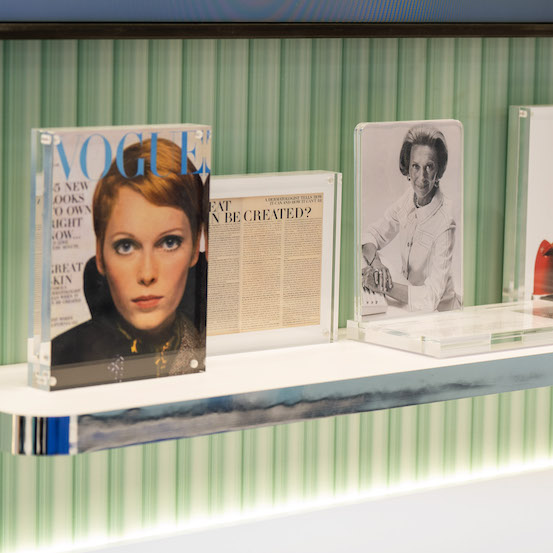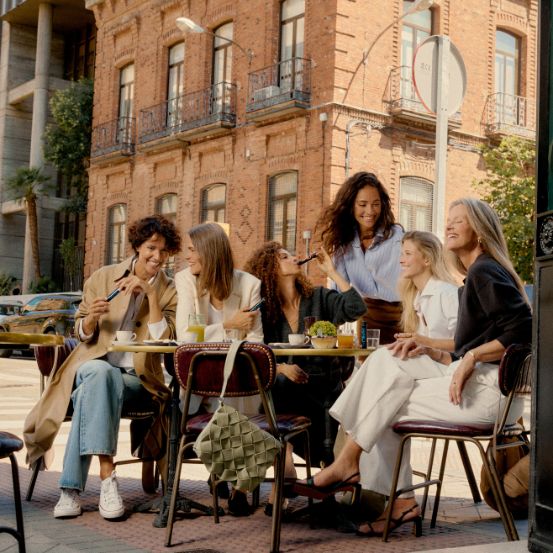The newly-opened museum is a tribute to the designer and his long-term partner, Pierre Bergé, who aimed to present the YSL displays in Paris and North Africa as a visual counterbalance
Sitting on a solid stone bench, looking out at the trickling fountain and Moroccan terracotta walls, Madison Cox – the keeper of the Yves Saint Laurent flame since the death of Pierre Bergé in September – made an iconoclastic statement.
“This mono-museum is dynamic, it has exemplary work, it’s alive,” Madison said. “But I hope it opens up a little bit. Pierre would never have allowed a dialogue between Saint Laurent and his generation – and the one that followed.
“But what was going on at the same time the Mondrian came out?” he continued, referring to the famous colour-block dress of 1965, which opens the exhibition. “What other designers were inspired by that African collection or by mixing fuchsia, turquoise and lime green?”
My mind was immediately taken with the idea of sneaking into the exquisite line-up of painterly evening gowns by Saint Laurent the work of another designer – say Haider Ackermann. And why not place beside the raw, tribal African outfit from 1967, with its conical breasts, the same look taken up by Jean Paul Gaultier in the 1980s, and later worn by his client Madonna, in 1990 on her “Blond Ambition” tour?
Since the new Marrakesh museum – a homage to the influence of the North African heritage on Saint Laurent – was already complete before Bergé’s death on 8th September, it is no surprise that the exhibition is not the “compare and contrast” idea of Madison, letting other designers in on this fashion festival.
The cavernous, curving, permanent museum displays; temporary display areas; well-crafted auditorium; and the excellent book and library spaces are as precise and Yves-centric as expected. Yet at the same time, the modernist African architecture by Studio KO, set against the poetic and artistic Saint Laurent creations, succeeds in catching the essence of the couturier who invented so many things we now take for granted, from trouser suits for women to the concept of black as a colour.
Betty Catroux, model-muse and one of Saint Laurent’s inner circle, laughed at her passion for black, even if she was dressed unexpectedly in a dark-brown animal print. “I have so many memories – of being with him, also here in Marrakesh – and I feel that he is watching over us,” she said.
Indeed. For there is a giant image of a young Saint Laurent by Jeanloup Sieff dominating the display, whose stenography was designed by Christopher Martin. Below the gaze of this sensitive, elegant, hippie-de-luxe Yves, the visitor is faced with two contrasting visions. On one side are black outfits, the depth, texture and decoration of the fabrics creating a sense of shaded colour; while the area opposite is alive with colour and the African influences that the designer had deep in his soul, which could be traced back to his upbringing in Algeria, as well as his discovery of Marrakesh in 1966.
“He bought a house and went there regularly,” explained Bergé back in June, when the Marrakesh site was completed as a parallel to the transformation into a museum of the former Yves Saint Laurent couture house at 5, avenue Marceau in Paris.
Throughout the Marrakesh show – in a more powerful way than at the more enclosed Paris museum – digital projections bring the upper half of the tall, dark walls to light. Dominique de Roche, who has worked for Saint Laurent for three decades, was responsible for choosing the most evocative outfits and images for this section. There are also videos of key moments in the YSL history, such as the Spring 2002 Couture show at the Centre Pompidou in Paris, which marked his retirement from ready-to-wear by sending 40 years of ground-breaking outfits on to the runway. The same film was shown at a mighty public screening on the Jemaa el-Fnaa in the centre of Marrakesh.
Even those residents who were more committed to the simultaneous Friday prayers than the museum opening could only be impressed by the fact that one of their city roads has been named “Yves Saint Laurent” – a feat of delicate diplomacy, according to Madison.
The pinky-red museum building, with its Cubist Moroccan-terracotta bricks, had its ribbon cut by Princess Lalla Salma, wife of Morroco’s King Mohammed VI. Madison enthused, “Even Morroccans that don’t know Yves’ work are proud of him; they’ve sort of appropriated him. They’ve realised that he was so enthused by them and they in turn have embraced him.”
The challenge with having a solo show is that it is impossible to recreate the moment that makes a fashion designer capture what the French call “l’air du temps” – the spirit of the times. The shock and awe of women wearing trousers in public, ready to break the glass ceiling and stride into the boardroom, means nothing to millennials, who see 60-somethings such as America’s Hilary Clinton and Germany’s Angela Merkel striding through the political universe in mannish trouser suits. It is a tough call for a curator to explain, visually, how sensual and daring such outfits seemed when Saint Laurent proposed them as the way for dynamic young women to dress. Maybe that is why the famous tuxedo or “le Smoking” of 1966 plays such a minor role in the exhibition, appearing in a small group of trouser suits after an opening corridor of photographs telling four decades of fashion history.
In this museum, it is the “hippie de luxe” style that leaves a lasting impact. Marisa Berenson, wearing her own vintage YSL high-waisted trousers and chunky Berber-style jewellery, said: “I had tears in my eyes remembering that time, hearing those voices of Yves and Pierre… We were so lucky to have lived through that period.”
The joyous display of accessories shows Saint Laurent’s inventiveness and inspirations to great effect, especially when using historic Parisian gloves or chunky, Berber tribal jewellery. The museum also shows beautifully the exceptional and artistic workmanship, such as the jackets embroidered by Maison Lesage of Van Gogh sunflowers and irises from the late 1980s. I thought of Madison’s comments and imagined how YSL’s work might look even more dramatic in the context of a Comme des Garçons outfit from the same period.
How much was Yves himself interested in and involved with Marrakesh? Pictures of the period suggest a young man in a dream world of coloured drapes and exotic tiles. Yet the YSL history surely deserves its place in the Moroccan sun. A few steps away from the new museum there is living evidence of the effect Bergé and Saint Laurent had on the city itself in the Jardin Majorelle, a 12-acre, landscaped artist’s garden that the duo rescued from bulldozers in 1980.
Its palm trees and greenery swaying in the breeze, as a background to the Majorelle blue of sculptures and a Berber museum, are living proof that Saint Laurent has given as much to Marrakesh as he drew out in inspiration.
Most popular


Relacionados
.jpg)




